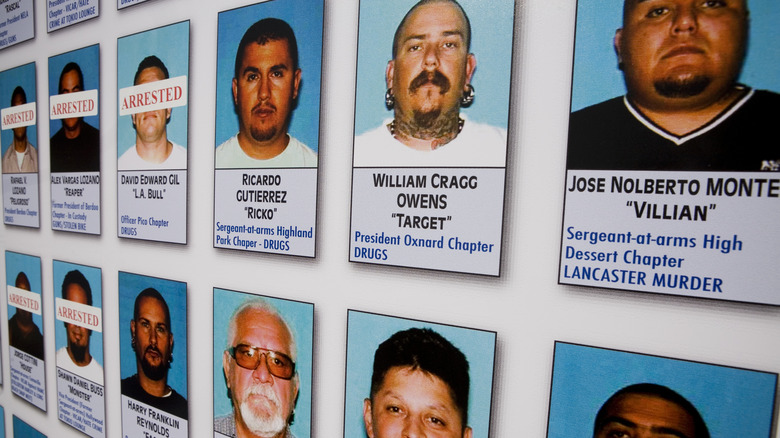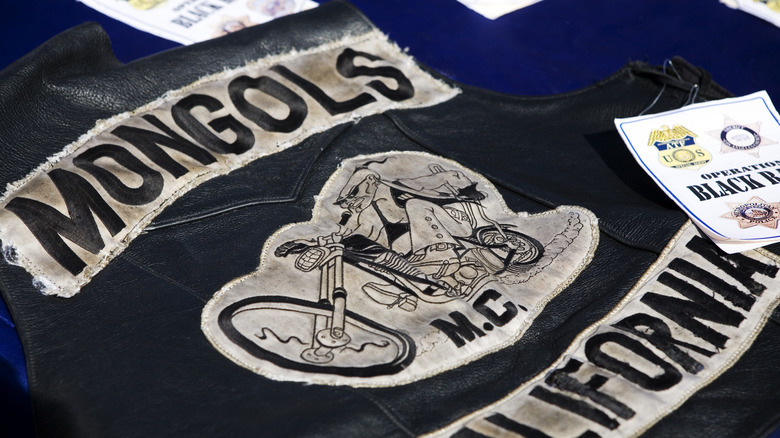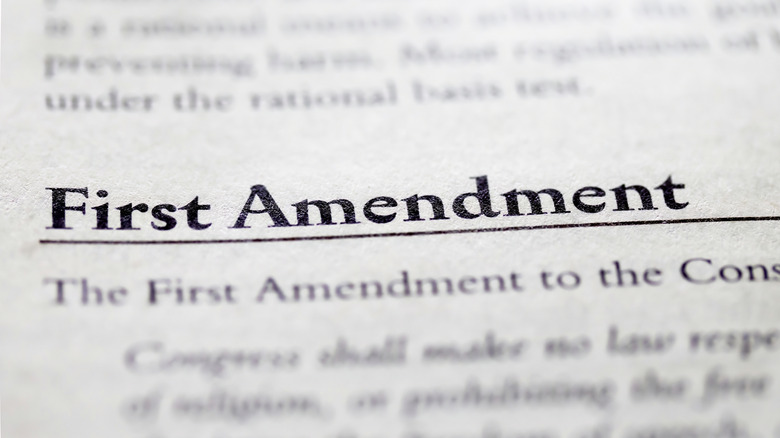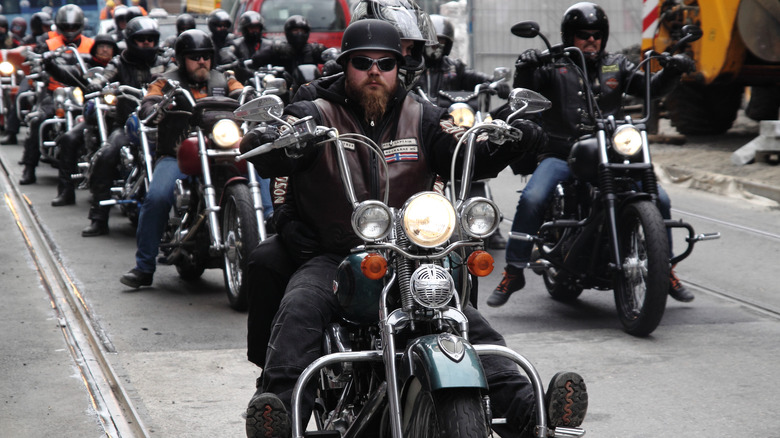The History Of The Mongols Motorcycle Club Explained
The concept of the outlaw is an old one, dating back to medieval England. Those who failed to adhere to the system, be it courts or the local lord, would be declared outside the protection of the law. Their civil rights were rescinded; anyone could capture or even kill the outlaw and expect no penalty. It was a judicial mechanism for a decentralized world.
The concept has long since been abolished as a punitive legal measure, but it thrives in the folklore of the United States. From criminals punitively ordered to colonies to the pirates that once wreaked havoc along the southeastern coastline to the gangs of the Old West, the rogue living outside the bounds of the law carries a lasting romantic appeal.
Modern outlawry is no longer thought of as an exile from society but a rejection of it. In its contemporary iteration, the outlaw refuses the laws of the land. It can take many forms, ranging from political violence to anarchist nihilism, but the most visible form of modern outlaw wears his heart on his sleeve. Or, more accurately, stitched across his back.
Modern motorcycle gangs and their genesis
The first outlaw motorcycle club in the United States started in a bar near Chicago in 1935, simply named the Outlaws. Motorcycle clubs were not uncommon then, but the Outlaws dedicated themselves to violence and crime. Their behavior and motto — "God forgives, Outlaws don't" — would inspire many over the following decade.
The end of World War II saw thousands of young men returning to the United States, many of whom were not content the quiet life. Fueled by memories of violence and the fraternal bonds of war, they found a new sense of brotherhood in their shared passion for riding motorcycles and the outlaw mindset. Of these new groups, many demanded that members ride nothing but motorcycles from the iconic and historic Harley Davidson brand.
The first time an outlaw motorcycle gang really made the headlines was in 1947. The subtly monikered Pissed Off Bastards of Bloomington turned an American Motorcyclist Association (AMA) sponsored hill climb event in Riverside, California, into a riot. The following year, it happened again, this time with two deaths. The exasperated Riverside police chief declared outlaw visitors responsible for the violence. Embracing the infamy, outlaw motorcycle gangs flourished.
In 1950, the Pissed Off Bastards rebranded, adopting the name of a specific World War II B-17 bomber Flying Fortress called Hell's Angels (they dropped the apostrophe, though). After that, the Pagans arrived in 1959, and the Bandidos in 1966. Along with the Outlaws, these gangs made up the big four outlaw motorcycle clubs. However, there would be another.
Segregated outside the law
The Mongol Nation Motorcycle Club rose from the streets of east Los Angeles in the late 1960s. Fresh from the violence of a new war, Vietnam veterans turned to motorcycles and the outlaw lifestyle for the same reasons the previous generation had after World War II. At the time, established organizations like the Hells Angels forbade Hispanic and African-American membership. Founding members incorporated the club in Montebello, California, on December 5, 1969. They chose a sketch of the historical Mongol marauder Genghis Khan as its logo.
Among the inaugural members, the Mongols' first sergeant-at-arms, Alfonso "Big Al" Aceves, represented the sort of young men who would become attracted to the club. Aceves had come from an abusive home, and his world only got darker as he served two tours in Vietnam as a member of the 101st Airborne Division. Addicted to violence, the outlaw lifestyle appealed to him and others like him.
Unlike some motorcycle clubs, which turned to crime to fund their lifestyle, the Mongols embraced criminality early. In 1974, the club voted to fully embrace the criminal lifestyle.
The Mongols expanded rapidly in the early days, with chapters springing up around California and beyond. But a problem loomed: outlaw biker gangs are fiercely territorial, and the biggest motorcycle club in California, the Hells Angels, had long since claimed the state for themselves.
Mongols go to war
Friction was inevitable. In 1977, a brawl broke out at a swap meet in Anaheim, California. No one was killed, but the event marked the beginning of a lifelong antipathy between the groups. The core of the conflict centered around control over the methamphetamine trade. With income at stake and an established affinity for violence in both groups, lethality followed.
On September 5, 1977, Mongol president Emerson Morris and member Raymond Smith were riding home from a bike run. Unbeknownst to the Mongols, an ambush waited. A group of Hells Angels gunned down the Mongols, killing both men. While the bodies awaited burial, someone delivered a bouquet of red-and-white (Hells Angels colors) flowers to the Conrad Mortuary, where they lay. Shortly after, a car bomb exploded, wounding two more Mongols.
Mongols sought revenge. A spate of killings ensued as a deadly tug-of-war for control of California's drug trade played out in the headlines. Angels shot Mongols. Mongols bombed Angels. Mongols who murdered Hells Angels earned the honor of having the club's motto, "Respect Few, Fear None." tattooed on their bodies.
The war eventually subsided, albeit temporarily, with a truce. Under the terms, the Mongols retained the right to wear the California rocker but were forbidden from expanding into Northern California, which would be Hells Angels territory.
It was a significant victory for the upstart club, which soon turned to expanding its operations even further.
[Featured image by Alex Schmitt via Wikimedia Commons | Cropped and scaled | CC BY-SA 2.0]
Recruitment and expansion
Suddenly unencumbered by the war with the Hells Angels, the Mongols began to expand. New chapters opened across state lines as the Mongols spread across the southwest. The club recruited members from amongst those cast out by other clubs, active gang members, and inmates recently released from prison.
Becoming a member was no simple task. Those interested in donning the colors would begin to associate with the club. If everything went right and the potential member met the requirements, he would be promoted to prospect. Any prospect ordered to do something by a full member must comply. Prospects who received approval from the club would be voted in as full-patch members, receiving their club colors. The process could take anywhere from six months to three years.
Members paid monthly fees and were required to attend meetings at their local chapter, each of which paid its dues to the Mother Chapter in Commerce, California. A seventy-page constitution defined the culture, outlining what Mongols could and could not do.
The entire organization was hierarchical. A national president stood at the top, assisted by a vice president, sergeant-at-arms (in charge of security), and Treasurer/Secretary. On paper, the command structure looked a bit like that of an infantry company. Or the mafia.
Orders flowed down, money flowed up, and the Mongols grew. Within 10 years, the club had chapters all over southern California. Later, it even looked abroad, establishing chapters as far afield as Germany, Austria, and Thailand.
The Laughlin River riot
As the organization grew, law enforcement paid increasing attention. The Mongols joined the Outlaws, Hells Angels, Bandidos, and Pagans as one of the "Big Five" most significant outlaw gangs as identified by law enforcement.
However, law enforcement was hardly the Mongols' only problem. Violence was never out of the question in a world of shifting alliances. Aligning themselves with the Mexican Mafia-Sureño coalition in addition to the Bandidos, Outlaws, Sons of Silence, and Pagans motorcycle clubs, disagreements over money and territory could turn violent, as it did with the Mexican Mafia.
However, the Hells Angels and its allies would always remain enemies; the early bad blood never faded. In 2002, it exploded in a fatal brawl at a casino known as Harrah's. Over 80,000 people flooded the Laughlin River, Nevada, for a motorcycle run. The expected hijinks ensued. Drinking, partying, and loud motorcycles abounded, and members of multiple motorcycle gangs attended.
The trouble started in the wee hours of the morning when a group of Hells Angels confronted members of the Mongols gambling at Harrah's Hotel and Casino. Lasting hatred combined with the tension of turf wars burst into violence. Hotel surveillance video recorded a melee during which dozens of bikers fought with guns, knives, wrenches, and fists. Three people died in the fracas as civilians scrambled for safety.
The highly publicized battle garnered worldwide attention, but it was no surprise to law enforcement. In fact, unbeknownst to the Mongols, a federal agent was in their midst.
Black rain falling
In October 2008, federal agencies arrested nearly 80 Mongol members in culmination of a years-long sweeping investigation. An agent of the Bureau of Alcohol, Tobacco, Firearms, and Explosives (ATF) named Billy Queen had posed as a biker who wanted to become a Mongol.
During his two years undercover, the line between law enforcement and lawbreaker blurred. Queen allegedly rode stolen Harleys, brawled alongside Mongols, and even became a prospect, then a full-patch member before rising to the position of vice president of his chapter. He wasn't the only one. Mongols who served as informants introduced at least four federal agents into the organization.
Operation Black Rain dealt the club a devastating but hardly fatal blow. The Feds executed 110 arrest warrants and 160 search warrants across California, Nevada, Colorado, Washington, and Ohio. Dozens of members were arrested, including former national president Ruben Cavazos.
Despite the efforts of the justice system, the Mongols carried on. Some even embraced the celebrity the case brought, offering to serve as extras or consultants on the film optioned from Queen's book.
The government shifted tack, focusing on copyright rather than criminality.
Constitutional battle
Symbols are an integral part of biker gang culture. A member's most valued item is not his Harley-Davidson (or in the case of some British clubs, the reliable Triumph motorcycle) but his gang's colors. Members wear their insignia with pride, identifying themselves to each other and the world as club members. Tattoos tell the tale of everything from sexual exploits to acts of violence committed in the name of the club.
The Department of Justice (DOJ) focused on removing that power from the Mongols, using the Racketeer Influence and Corrupt Organizations (RICO) Act. It wasn't the first time the U.S. government indicted an unpopular organization with RICO. A piece of legislation passed in 1970 designed to aid law enforcement in attacking organized crime. When the Mongol Nation was found guilty of racketeering and conspiracy in December 2018, the U.S. District Court decreed that they would have to forfeit their trademark.
A higher court disagreed. Judge David O. Carter upheld the conviction but rejected the stripping of the trademark based on the First Amendment's guarantee of freedom of expression. While the case may not have gone how the DOJ hoped, it speaks to the government's desire to dismantle organizations like the Mongols.
The state of the Mongols
Despite enduring battles with formidable opponents like the Hells Angels and the federal government, the Mongols Motorcycle Club continues to operate. While it has faced challenges in recruitment, it remains a visible force in the world of organized crime.
Law enforcement estimates that the Mongols have a global reach, with as many as 2,000 full-patch members. The club's influence extends from the United States to Australia, where the Finks' motorcycle club "patched over" — converted — to Mongols in 2013, and to numerous other countries, including Belgium, France, Germany, Brazil, Italy, Malaysia, Mexico, Canada, Indonesia, Singapore, Sweden, and Thailand.
The Mongols present themselves as law-abiding members of a social club, while the government categorizes them as an organized criminal enterprise. The reality likely lies in the middle, with elements of both identities coexisting within the club.
Whatever the case, it doesn't look like the Mongols or its fellow motorcycle clubs are going anywhere soon. As long as there are disaffected men, whether veterans or simply those seeking association with like-minded fellows, there will be a marginal space in society for them to gather.








